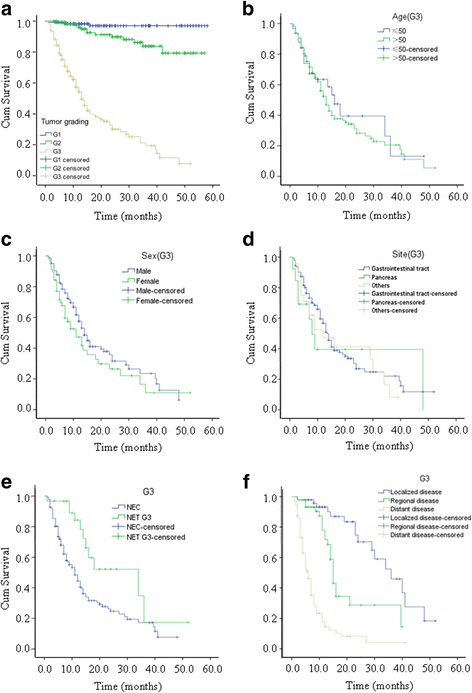Clinicopathological features and prognosis of gastroenteropancreatic neuroendocrine neoplasms in a Chinese population: a large, retrospective single-centre study
- PMID: 28705205
- PMCID: PMC5508659
- DOI: 10.1186/s12902-017-0190-6
Clinicopathological features and prognosis of gastroenteropancreatic neuroendocrine neoplasms in a Chinese population: a large, retrospective single-centre study
Abstract
Background: Gastroenteropancreatic neuroendocrine neoplasms (GEP-NENs) are the most common type of neuroendocrine tumors, accounting for more than half of neuroendocrine neoplasms (NENs). We performed a retrospective study in our center to investigate the clinicopathological features, risk factors of metastasis, and prognosis of GEP-NENs in a Chinese population.
Methods: Four hundred forty patients with GEP-NENs treated at the First Affiliated Hospital of Zhengzhou University between January 2011 and March 2016 were analyzed retrospectively. Multivariate logistic regression was performed to identify independent risk factors for metastasis of the tumors. The Kaplan-Meier method was used for survival analysis, and log-rank tests for comparisons among groups.
Results: Primary sites were the stomach (24.3%), rectum (24.1%), pancreas (20.5%), esophagus (12.3%), unknown primary origin (UPO-NEN) (8.0%), duodenum (6.1%). Three hundred eighty-nine of the 440 GEP-NENs cases (88.4%) were non-functional tumors, and patients had non-specific symptoms, which could have led to delay in diagnosis and treatment. Neuroendocrine tumor, neuroendocrine carcinoma, and mixed adenoendocrine carcinoma were 56.8%, 33.2% and 3.2%, respectively, of the cases. One hundred thirty (29.5%) of the tumors were G1, 120 (27.3%) G2, and 190 (43.2%) G3. The immunohistochemical positive rate of synaptophysin was 97.7% and of chromogranin 48.7%. Logistic regression analysis revealed that the diameter and pathological classification of tumors were the most important predictors for metastasis. The median survival time was 34 months for patients with well-differentiated neuroendocrine tumors grade G3 and 11 months for poorly differentiated neuroendocrine carcinoma. The median survival time of patients with localized disease, regional disease, and distant disease was 36 months, 15 month, and 6 months, respectively.
Conclusions: This study constitutes a comprehensive analysis of the clinicopathological features of GEP-NENs in a Chinese population. GEP-NENs may occur at any part of the digestive system. The diameter and pathological classification of tumor are the most important predictors for metastasis. The prognosis is poor for patients with poorly differentiated neuroendocrine cancers and distant metastases.
Keywords: Carcinoid tumor; Gastrinoma; Gastro enteropancreatic neuroendocrine tumors; Islet cell tumor; Neuroendocrine cancers; Neuroendocrine neoplasms; Neuroendocrine tumors.
Conflict of interest statement
Ethics approval and consent to participate
Ethical approval for this study was obtained from the Ethics Committee of the First Affiliated Hospital of Zhengzhou University. Zhengzhou, China. Informed consent was obtained prior to the conduct of any study-related procedures. And written consent of minors was obtained from the participants’ parents or legal guardians. The study was performed in compliance with the Declaration of Helsinki and the Good Clinical Practice (GCP) Guidelines.
Consent for publication
Not applicable.
Competing interests
The authors declare that they have no competing interests.
Publisher’s Note
Springer Nature remains neutral with regard to jurisdictional claims in published maps and institutional affiliations.
Figures

Similar articles
-
Clinicopathologic characteristics and prognosis of gastroenteropancreatic neuroendocrine neoplasms: a multicenter study in South China.Chin J Cancer. 2017 Jun 21;36(1):51. doi: 10.1186/s40880-017-0218-3. Chin J Cancer. 2017. PMID: 28637502 Free PMC article.
-
Clinical, pathological and prognostic characteristics of gastroenteropancreatic neuroendocrine neoplasms in China: a retrospective study.BMC Endocr Disord. 2014 Jul 8;14:54. doi: 10.1186/1472-6823-14-54. BMC Endocr Disord. 2014. PMID: 25001493 Free PMC article.
-
Gastroenteropancreatic neuroendocrine neoplasms: a 10-year experience of a single center.Pol Arch Med Wewn. 2015;125(5):337-46. doi: 10.20452/pamw.2832. Epub 2015 Apr 29. Pol Arch Med Wewn. 2015. PMID: 25924181
-
Gastroenteropancreatic neuroendocrine neoplasms: current development, challenges, and clinical perspectives.Mil Med Res. 2024 Jun 4;11(1):35. doi: 10.1186/s40779-024-00535-6. Mil Med Res. 2024. PMID: 38835066 Free PMC article. Review.
-
Gastroenteropancreatic neuroendocrine neoplasms: epidemiology, genetics, and treatment.Front Endocrinol (Lausanne). 2024 Sep 30;15:1424839. doi: 10.3389/fendo.2024.1424839. eCollection 2024. Front Endocrinol (Lausanne). 2024. PMID: 39411312 Free PMC article. Review.
Cited by
-
LncNEN885 inhibits epithelial-mesenchymal transition by partially regulation of Wnt/β-catenin signalling in gastroenteropancreatic neuroendocrine neoplasms.Cancer Sci. 2018 Oct;109(10):3139-3148. doi: 10.1111/cas.13747. Epub 2018 Aug 18. Cancer Sci. 2018. PMID: 30033597 Free PMC article.
-
Neuroendocrine carcinoma of the gastric stump: A case report and literature review.World J Gastroenterol. 2018 Jan 28;24(4):543-548. doi: 10.3748/wjg.v24.i4.543. World J Gastroenterol. 2018. PMID: 29398875 Free PMC article.
-
Clinicopathological features and prognostic factors associated with gastroenteropancreatic mixed neuroendocrine non-neuroendocrine neoplasms in Chinese patients.World J Gastroenterol. 2021 Feb 21;27(7):624-640. doi: 10.3748/wjg.v27.i7.624. World J Gastroenterol. 2021. PMID: 33642833 Free PMC article.
-
Association between MGMT status and response to alkylating agents in patients with neuroendocrine neoplasms: a systematic review and meta-analysis.Biosci Rep. 2020 Mar 27;40(3):BSR20194127. doi: 10.1042/BSR20194127. Biosci Rep. 2020. PMID: 32141507 Free PMC article.
-
Interest of Integrated Whole-Body PET/MR Imaging in Gastroenteropancreatic Neuroendocrine Neoplasms: A Retro-Prospective Study.Cancers (Basel). 2024 Jun 28;16(13):2372. doi: 10.3390/cancers16132372. Cancers (Basel). 2024. PMID: 39001434 Free PMC article.
References
-
- Yao JC, Hassan M, Phan A, Dagohoy C, Leary C, Mares JE, Abdalla EK, Fleming JB, Vauthey JN, Rashid A. One hundred years after "carcinoid": epidemiology of and prognostic factors for neuroendocrine tumors in 35,825 cases in the United States. J Clin Oncol. 2008;26(18):3063–3072. doi: 10.1200/JCO.2007.15.4377. - DOI - PubMed
-
- Bosman FT, Carneiro F, Hruban RH, Theise ND. WHO classification of tumours of the digestive system. 2010. p. 1089.
-
- Wang Y-h, Lin Y, Xue L, Wang J-h, Chen M-h, Chen J. Relationship between clinical characteristics and survival of gastroenteropancreatic neuroendocrine neoplasms: A single-institution analysis (1995-2012) in South China. BMC Endocr Disord. 2012;12(1):1–9. doi: 10.1186/1472-6823-12-1. - DOI - PMC - PubMed
Publication types
MeSH terms
Supplementary concepts
LinkOut - more resources
Full Text Sources
Other Literature Sources
Medical

